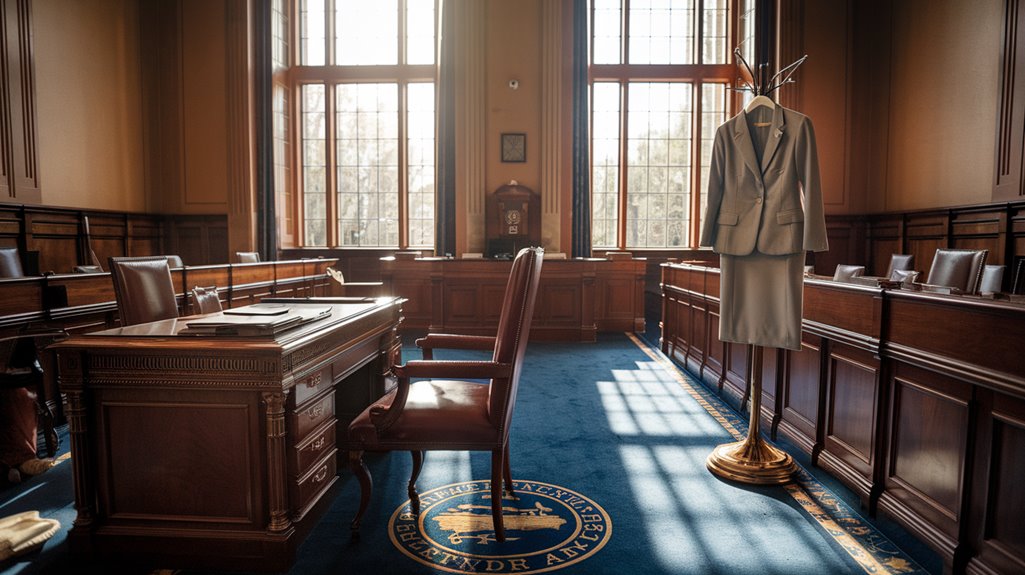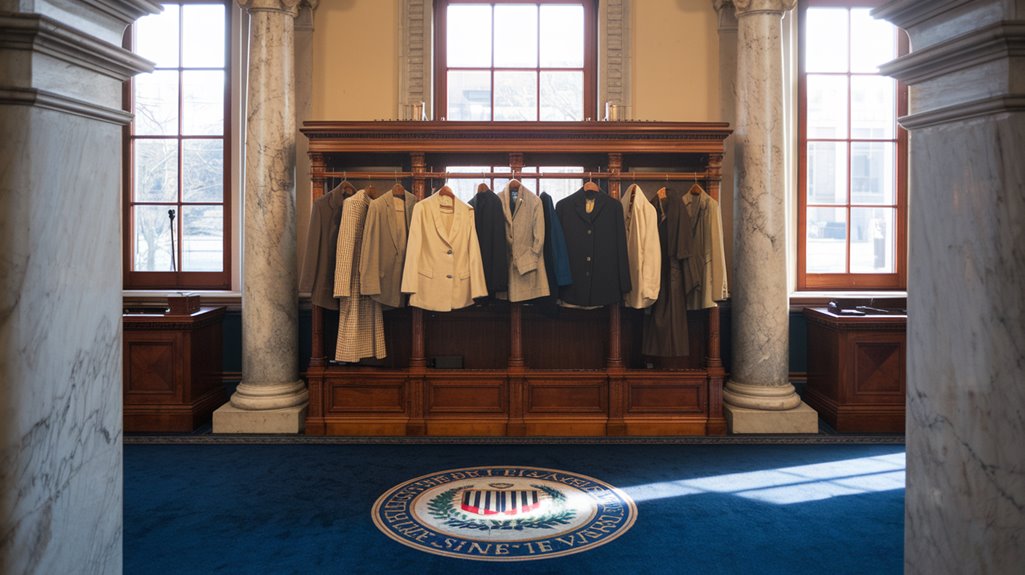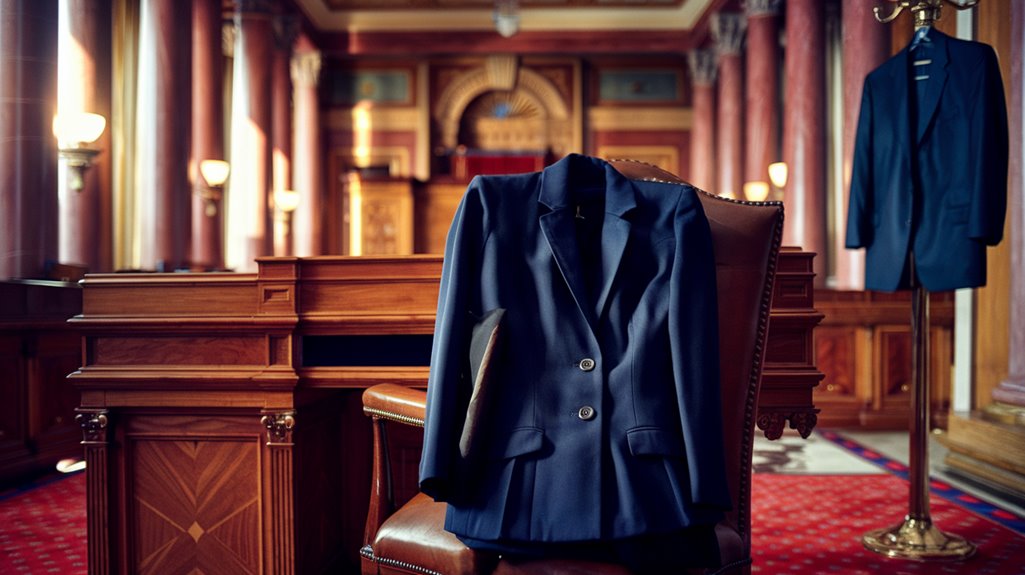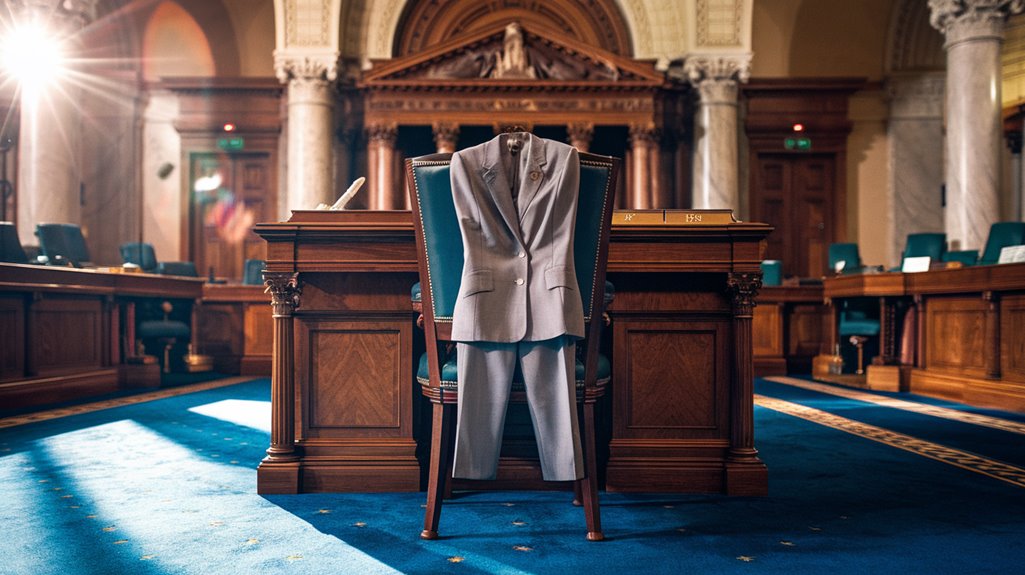Women Senators Couldn’t Wear Pants on the Senate Floor Until 1993
You might be surprised to learn that the U.S. Senate enforced an unwritten dress code banning women from wearing pants until 1993. While male senators freely chose their professional attire, female senators had to navigate strict, gender-specific rules that required skirts or dresses on the Senate floor. The restrictions reflected deeper inequalities within America's highest legislative body, and it took two bold senators to challenge this longstanding tradition. Their actions would transform more than just the Senate's dress code.
The Unwritten Rules of Senate Fashion

While today's Senate dress code is formally documented, the chamber's fashion rules were historically governed by unwritten customs and social expectations. The dress code evolution reflected society's changing norms, with the Senate's Sergeant at Arms and doorkeepers enforcing these informal standards through their control of chamber access.
You'll find that the fashion symbolism in the Senate carried significant weight, as business attire for men and formal dresses for women represented the institution's dignity. The recent unanimous passage resolution in September 2023 reinforced these long-held standards of decorum.
These unwritten rules weren't just about appearances – they embodied the Senate's traditional values and decorum. When societal attitudes shifted, individual senators began challenging these norms, leading to gradual changes. The COVID-19 pandemic brought about a major transformation in how senators viewed workplace attire.
The most notable modifications included allowing women to wear pants and accommodating religious headwear, demonstrating the Senate's slow but steady adaptation to modern sensibilities.
Early Resistance to Women's Professional Attire
The tradition of male-dominated workplaces shaped early resistance to women's professional attire. You'd find that dress codes, established by men, carried serious consequences for violations – from being sent home to losing your job.
The fashion evolution was particularly restrictive when it came to pants, which were typically forbidden in office settings. Before 1993, written Senate rules strictly prohibited women from wearing pants on the floor. In the mid-20th century, the absence of uniforms allowed women in resistance movements to express their evolving identities through clothing while navigating traditional expectations.
If you worked in these environments, you'd need to navigate complex gender norms carefully. Women had to balance professionalism with femininity, often adopting menswear patterns and traditional fabrics while maintaining feminine silhouettes to avoid societal backlash.
You couldn't simply wear what you wanted; skirts were the norm, and noncompliance could derail your career. Even as pantsuits gained acceptance in progressive workplaces during the 1960s, most professional settings continued to resist this change.
Breaking Barriers: The 1993 Pantsuit Revolution
Until 1993, an unwritten rule barred women from wearing pants on the Senate floor, with doorkeepers enforcing this antiquated dress code through strict gatekeeping and peer pressure.
You'll find that the change came when two pioneering senators, Carol Moseley-Braun and Barbara Mikulski, challenged this tradition by wearing pantsuits.
Mikulski sought approval from President pro tempore Byrd on a snowy day, while Moseley-Braun, the first African-American woman senator, wore pants without prior consultation.
Their bold actions led Senate sergeant-at-arms Martha Pope to officially amend the dress code, allowing "coordinated pantsuits" as acceptable attire. The 1972 dress code request had been previously ignored, making this change even more significant.
The year also marked significant progress as a record 32 women were elected to Congress, further cementing the importance of evolving dress codes and equal representation.
This pantsuit symbolism represented more than just a wardrobe change – it marked a vital victory for gender equality in one of America's most prestigious institutions, paving the way for female staff and journalists to follow suit.
Key Women Who Changed Senate History
Women's evolving role in the Senate extends far beyond dress code reforms, stretching back to 1922 when Rebecca Latimer Felton shattered the ultimate glass ceiling as America's first female senator.
Throughout the following decades, female pioneers continued to transform Congress. Hattie Caraway became the first elected woman senator in 1931, while Margaret Chase Smith made history in 1949 as the first woman to serve in both chambers. She joined a Congress that had ten female members, marking the first time women's representation reached double digits.
In 1993, Carol Moseley Braun made history when she wore an Armani pantsuit to the Senate floor, effectively challenging the longstanding dress code that prohibited women from wearing pants.
You'll find numerous legislative milestones marking women's progress, from Jeannette Rankin's groundbreaking election to the House in 1917 to Nancy Pelosi becoming the first female Speaker in 2007.
The numbers tell a compelling story: from a single woman in Congress in 1917 to reaching a record-breaking 128 women in the 116th Congress, women's representation has grown dramatically despite educational and societal barriers.
The Official Amendment and Its Implications

After years of unwritten restrictions, a pivotal moment in Senate history arrived when Martha Pope, the Senate sergeant at arms, formally amended the dress code policy to include pantsuits as acceptable attire for women.
The amendment specifically permitted "coordinated pantsuits" with matching blazers, though it excluded stirrup pants. This change wasn't just about clothing – it represented a significant step toward gender equality in one of America's most traditional institutions. Before this change, Senate doorkeepers strictly monitored and controlled access based on women's attire. Carol Moseley-Braun challenged these norms when she first wore a pantsuit on the Senate floor in early 1993.
You'll find it particularly remarkable that this modification came during a time when more women were entering the Senate than ever before.
The impact of this dress code revision extended beyond the Senate floor. It validated women's professional choices and reflected the broader cultural shifts of the 1990s, setting a precedent for future generations of female legislators.
A Legacy of Progress in Congressional Culture
The legacy of pants in the Senate extends far beyond a simple dress code amendment. The 1993 change sparked broader cultural shifts that transformed Congressional culture, leading to significant improvements in workplace equality and fashion evolution.
You'll find these lasting impacts reflected in various institutional changes:
- Creation of women's restrooms near both Senate and House floors
- Introduction of lactation suites in Senate office buildings
- Modernization of dress codes to include sleeveless attire
- Implementation of harassment protection policies
- Accommodation for working mothers with babies in Senate chambers
The Congressional Accountability Act in 1995 established crucial protections against workplace discrimination and harassment.
These changes demonstrate how the pantsuit victory opened doors for more inclusive policies.
What started as a fashion statement by Senators Moseley-Braun and Mikulski evolved into a catalyst for extensive reforms, making Congress more accessible and equitable for women.
 five female senators were serving simultaneously for the first time in history.
five female senators were serving simultaneously for the first time in history.










